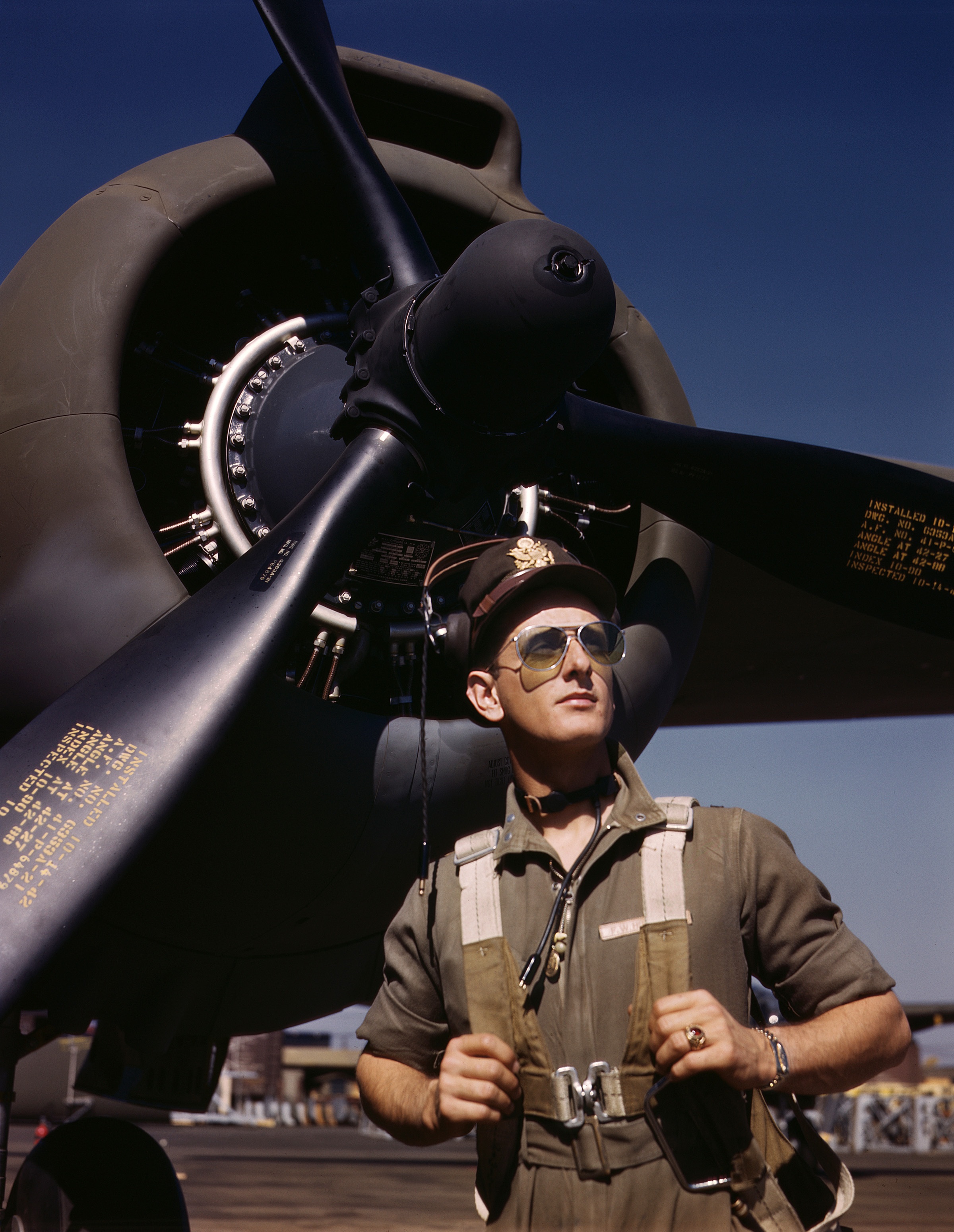|
Joseph A. Walker
Joseph Albert Walker (February 20, 1921 – June 8, 1966) ( Capt, USAF) was an American World War II pilot, experimental physicist, NASA test pilot, and astronaut who was the first person to fly an airplane to space. He was one of twelve pilots who flew the North American X-15, an experimental spaceplane jointly operated by the Air Force and NASA. In 1961, Walker became the first human in the mesosphere when piloting Flight 35, and in 1963, Walker made three flights above 50 miles, thereby qualifying as an astronaut according to the United States definition of the boundary of space. The latter two, X-15 Flights 90 and 91, also surpassed the Kármán line, the internationally accepted boundary of 100 kilometers (62.14 miles). Making the latter flights immediately after the completion of the Mercury and Vostok programs, Walker became the first person to fly to space twice. He was the only X-15 pilot to fly above 100 km during the program. Walker died in a group ... [...More Info...] [...Related Items...] OR: [Wikipedia] [Google] [Baidu] |
USAF
The United States Air Force (USAF) is the Air force, air service branch of the United States Department of Defense. It is one of the six United States Armed Forces and one of the eight uniformed services of the United States. Tracing its origins to 1 August 1907, as a part of the United States Army Signal Corps, the USAF was established by transfer of personnel from the Army Air Forces with the enactment of the National Security Act of 1947. It is the second youngest branch of the United States Armed Forces and the fourth in United States order of precedence, order of precedence. The United States Air Force articulates its core missions as air supremacy, intelligence, surveillance, target acquisition, and reconnaissance, global integrated intelligence, surveillance and reconnaissance, airlift, rapid global mobility, Strategic bombing, global strike, and command and control. The United States Department of the Air Force, Department of the Air Force, which serves as the USAF's ... [...More Info...] [...Related Items...] OR: [Wikipedia] [Google] [Baidu] |
X-15 Flight 91
X-15 Flight 91 was an August 22, 1963 American crewed sub-orbital spaceflight, and the second and final flight in the program to fly above the Kármán line, which was previously achieved during Flight 90 a month earlier by the same pilot, Joseph A. Walker. It was the highest flight of the X-15 program. Flight 91 was the first internationally recognized spaceflight of a reused spacecraft, as Walker had also flown plane number three on the previous sub-orbital spaceflight over the Kármán line on July 19. The flight was air-launched from a modified Boeing B-52 Stratofortress support plane over Smith Ranch Dry Lake, Nevada, United States. Walker piloted the X-15 to an altitude of 107.96 km and remained weightless for approximately five minutes. The altitude was the highest crewed flight by a spaceplane to that time, and remained the record until the 1981 flight of Space Shuttle ''Columbia''. Walker landed the X-15 about 12 minutes after it was launched, at Rogers Dry Lake ... [...More Info...] [...Related Items...] OR: [Wikipedia] [Google] [Baidu] |
Vostok Programme
The Vostok programme ( ; rus, Восток, p=vɐˈstok, a=ru-восток.ogg, t=East) was a Soviet human spaceflight project to put the first Soviet cosmonauts into low Earth orbit and return them safely. Competing with the United States Project Mercury, it succeeded in placing the first human into space, Yuri Gagarin, in a single orbit in Vostok 1 on April 12, 1961. The Vostok capsule was developed from the Zenit spy satellite project, and its launch vehicle was adapted from the existing R-7 Semyorka intercontinental ballistic missile (ICBM) design. The name "Vostok" was treated as classified information until Gagarin's flight was first publicly disclosed to the world press. The programme carried out six crewed spaceflights between 1961 and 1963. The longest flight lasted nearly five days, and the last four were launched in pairs, one day apart. This exceeded Project Mercury's demonstrated capabilities of a longest flight of just over 34 hours, and of single missions. ... [...More Info...] [...Related Items...] OR: [Wikipedia] [Google] [Baidu] |
Project Mercury
Project Mercury was the first human spaceflight program of the United States, running from 1958 through 1963. An early highlight of the Space Race, its goal was to put a man into Earth orbit and return him safely, ideally before the Soviet Union. Taken over from the US Air Force by the newly created civilian space agency NASA, it conducted 20 uncrewed developmental flights (some using animals), and six successful flights by astronauts. The program, which took its name from Roman mythology, cost $ (adjusted for inflation). The astronauts were collectively known as the " Mercury Seven", and each spacecraft was given a name ending with a "7" by its pilot. The Space Race began with the 1957 launch of the Soviet satellite Sputnik 1. This came as a shock to the American public, and led to the creation of NASA to expedite existing US space exploration efforts, and place most of them under civilian control. After the successful launch of the Explorer 1 satellite in 1958, crewed spac ... [...More Info...] [...Related Items...] OR: [Wikipedia] [Google] [Baidu] |
Kármán Line
The Kármán line (or von Kármán line ) is a conventional definition of the Outer space#Boundary, edge of space; it is widely but not universally accepted. The international record-keeping body Fédération Aéronautique Internationale, FAI (Fédération aéronautique internationale) defines the Kármán line at an altitude of above above mean sea level, mean sea level. While named after Theodore von Kármán, who calculated a theoretical limit of altitude for aeroplane flight at above Earth, the later established Kármán line is more general and has no distinct physical significance, in that there is a rather gradual difference between the characteristics of the atmosphere at the line, and experts disagree on defining a distinct boundary where the atmosphere ends and space begins. It lies well above the altitude reachable by conventional airplanes or high-altitude balloons, and is approximately where satellites, even on very eccentric trajectories, will Orbital decay, dec ... [...More Info...] [...Related Items...] OR: [Wikipedia] [Google] [Baidu] |
Mesosphere
The mesosphere (; ) is the third layer of the atmosphere, directly above the stratosphere and directly below the thermosphere. In the mesosphere, temperature decreases as altitude increases. This characteristic is used to define limits: it begins at the top of the stratosphere (sometimes called the stratopause), and ends at the mesopause, which is the coldest part of Earth's atmosphere, with temperatures below . The exact upper and lower boundaries of the mesosphere vary with latitude and with season (higher in winter and at the tropics, lower in summer and at the poles), but the lower boundary is usually located at altitudes from above sea level, and the upper boundary (the mesopause) is usually from . The stratosphere and mesosphere are sometimes collectively referred to as the "middle atmosphere", which spans altitudes approximately between above Earth's surface. The mesopause, at an altitude of , separates the mesosphere from the thermosphere—the second-outermost la ... [...More Info...] [...Related Items...] OR: [Wikipedia] [Google] [Baidu] |
Spaceplane
A spaceplane is a vehicle that can flight, fly and gliding flight, glide as an aircraft in Earth's atmosphere and function as a spacecraft in outer space. To do so, spaceplanes must incorporate features of both aircraft and spacecraft. Orbital spaceflight, Orbital spaceplanes tend to be more similar to conventional spacecraft, while sub-orbital spaceplanes tend to be more similar to fixed-wing aircraft. All spaceplanes as of 2024 have been rocket engine, rocket-powered for takeoff and climb, but have then landed as unpowered glider (aircraft), gliders. Four examples of spaceplanes have successfully launched to orbit, Atmospheric entry, reentered Earth's atmosphere, and Landing#Aircraft, landed: the U.S. Space Shuttle, Russian Buran (spacecraft), Buran, U.S. Boeing X-37, X-37, and the Chinese Shenlong (spacecraft), Shenlong. Another, Dream Chaser, is under development in the U.S. As of 2024 all past and current orbital spaceplanes VTHL, launch vertically; some are carried as ... [...More Info...] [...Related Items...] OR: [Wikipedia] [Google] [Baidu] |
North American X-15
The North American X-15 is a Hypersonic speed, hypersonic rocket-powered aircraft which was operated by the United States Air Force and the National Aeronautics and Space Administration (NASA) as part of the List of X-planes, X-plane series of experimental aircraft. The X-15 set speed and altitude records in the 1960s, crossing the Kármán line, edge of outer space and returning with valuable data used in aircraft and spacecraft design. The X-15's highest speed, , X-15 Flight 188, was achieved on 3October 1967, when William J. Knight flew at Mach number, Mach6.7 at an altitude of , or 19.34miles. This set the Flight airspeed record, official world record for the highest speed ever recorded by a crewed, powered aircraft, which remains unbroken. During the X-15 program, 12pilots flew a combined 199flights. Of these, 8pilots flew a combined 13flights which met the Air Force human spaceflight, spaceflight criterion by exceeding the altitude of , thus qualifying these pilots as bei ... [...More Info...] [...Related Items...] OR: [Wikipedia] [Google] [Baidu] |
Test Pilot
A test pilot is an aircraft pilot with additional training to fly and evaluate experimental, newly produced and modified aircraft with specific maneuvers, known as flight test techniques.Stinton, Darrol. ''Flying Qualities and Flight Testing of the Airplane.'' American Institute of Aeronautics and Astronautics, Inc., 1996, p. 265 History Test flying as a systematic activity started during the World War I, First World War, at the Royal Aircraft Establishment (RAE) in the United Kingdom. An "Experimental Flight" was formed at the Central Flying School. During the 1920s, test flying was further developed by the RAE in the UK, and by the National Advisory Committee for Aeronautics (NACA) in the United States. In the 1950s, NACA was transformed into the National Aeronautics and Space Administration, or NASA. During these years, as work was done into aircraft stability and handling qualities, test flying evolved towards a more qualitative scientific profession. In the 1950s, test ... [...More Info...] [...Related Items...] OR: [Wikipedia] [Google] [Baidu] |
Experimental Physicist
Experimental physics is the category of disciplines and sub-disciplines in the field of physics that are concerned with the observation of physical phenomena and experiments. Methods vary from discipline to discipline, from simple experiments and observations, such as experiments by Galileo Galilei, to more complicated ones, such as the Large Hadron Collider. Overview Experimental physics is a branch of physics that is concerned with data acquisition, data-acquisition methods, and the detailed conceptualization (beyond simple thought experiments) and realization of laboratory experiments. It is often contrasted with theoretical physics, which is more concerned with predicting and explaining the physical behaviour of nature than with acquiring empirical data. Although experimental and theoretical physics are concerned with different aspects of nature, they both share the same goal of understanding it and have a symbiotic relationship. The former provides data about the universe, wh ... [...More Info...] [...Related Items...] OR: [Wikipedia] [Google] [Baidu] |
Aviator
An aircraft pilot or aviator is a person who controls the flight of an aircraft by operating its directional flight controls. Some other aircrew members, such as navigators or flight engineers, are also considered aviators because they are involved in operating the aircraft's navigation and engine systems. Other aircrew members, such as drone operators, flight attendants, mechanics and ground crew, are not classified as aviators. In recognition of the pilots' qualifications and responsibilities, most militaries and many airlines worldwide award aviator badges to their pilots. Definition The first recorded use of the term ''aviator'' (''aviateur'' in French) was in 1887, as a variation of ''aviation'', from the Latin ''avis'' (meaning ''bird''), coined in 1863 by in ''Aviation Ou Navigation Aérienne'' ("Aviation or Air Navigation"). The term ''aviatrix'' (''aviatrice'' in French), now archaic, was formerly used for a female pilot. The term ''aviator'' (''aviateur'' ... [...More Info...] [...Related Items...] OR: [Wikipedia] [Google] [Baidu] |







